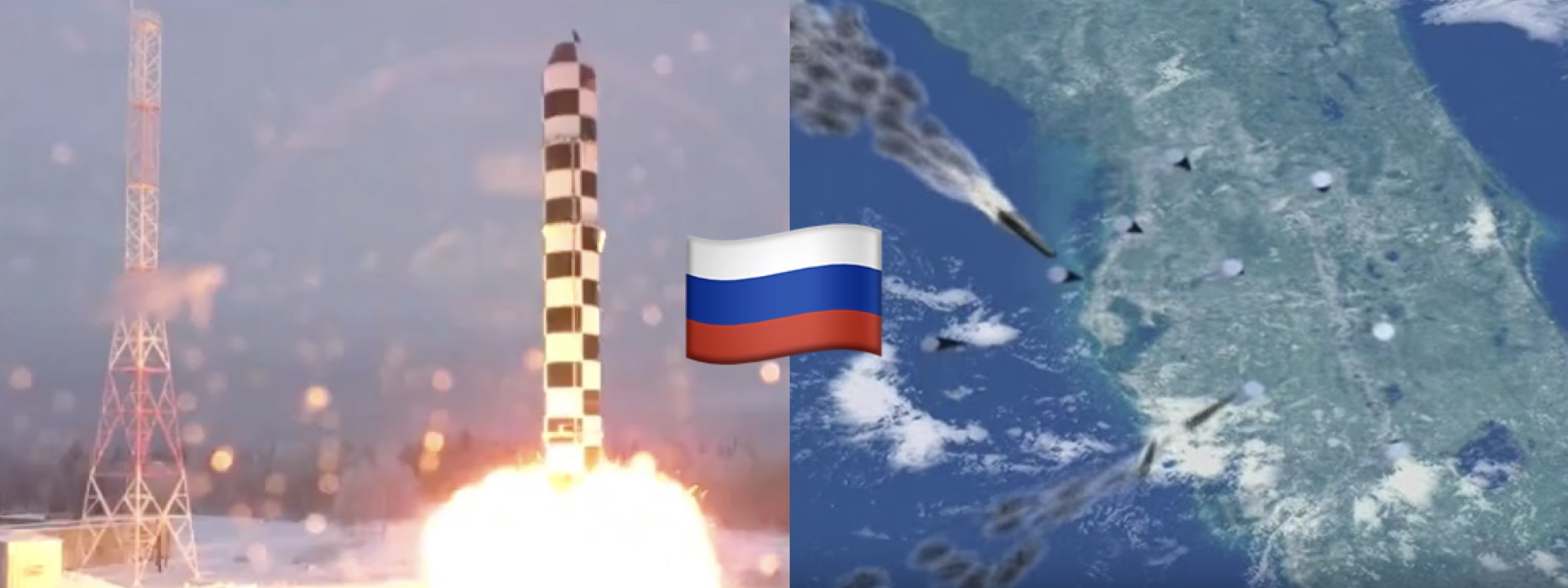#PutinAtWar: Putin’s Words, Missile Aim for Florida
Putin’s annual speech, and apparently a new missile, aimed at the United States
#PutinAtWar: Putin’s Words, Missile Aim for Florida

Putin’s annual speech, and apparently a new missile, aimed at the United States

On March 1, during the annual address to Russia’s Federal Assembly, President Vladimir Putin officially introduced the Russian Federation’s new intercontinental ballistic missile (ICBM). During the speech, Putin issued a number of subtle threats to the United States — verbally and visually. During Putin’s speech, a video of a Multiple Independently Targeted Re-entry Vehicle (MIRV) strike on Florida ran on two large monitors behind him.
The video was curiously familiar. @DFRLab investigated.
The new hypersonic RS-28 “Sarmat” (NATO reporting name: SS-X-30 Satan 2) ICBM reportedly completed all required testing and will soon replace the current R-36 “Satan” (NATO reporting name SS-18 Satan) ICBM.

https://www.rt.com/news/420157-russia-new-hypersonic-icbm/
According to Putin, Russia began developing the new ICBM capabilities as early as 2004, when the United States introduced the Aegis Ballistic Missile Defense System. The first successful test-launch of the missile was carried out by Russia in September 2016.
During Putin’s speech, a video revealed new details about the latest test-launch. Judging by the geolocation data in the video, it is most likely that the test was carried out in the Plesetsk Cosmodrome (Космодром «Плесецк»), north of Moscow. The tower in the video coincides with the Plesetsk towers, widely available in launch sites throughout the cosmodrome. The video was not published before and the test site is covered with snow, suggesting that the footage was captured recently, or at the very least during winter.

Here is the location of the possible launch site pinpointed on the map.
Chronological satellite imagery from 2014 to 2017 revealed that the Yubileynaya launch site underwent construction to include larger facilities and more activity during the same period of the ICBM testing.

The RS-28 serves among Russia’s deterrent and retaliation capability and is allegedly capable of penetrating all missile defense systems at a virtually unlimited range. According to Putin, the Unite States ignored the Kremlin’s warnings back in 2004 and will now be forced to listen.

The speech was supported with visualizations of RS-28 nuclear warheads striking undefined targets.
After a closer examination, @DFRLab confirmed the targeted territory to be the state of Florida, including the area around the city of Tampa, where an important military outpost — United States Central Command (CENTCOM) — is headquartered.

From the first glance, these low-quality video graphics appeared outdated for a major presentation by a head of state in 2018. After a deeper investigation, @DFRLab verified that the same graphics were used in a promotional video for the RS-28 predecessor — the R36 missile. The original graphics were made as early as 2007 for a Russian military documentary — “Стратегический Ракетный Комплекс “Сатана”, which introduced the much older R36 missile.
Conclusion
This case is joined by many recent examples of Russia escalating tensions and testing the limits of its relations with the United States. For instance, a few weeks ago, a brigade of Russian mercenaries attacked U.S. military positions in Syria, fifth generation Su-57 jet fighters were unexpectedly deployed to Khmeimim airbase, and now the United States was threatened with ICBMs.
Putin’s subtle and nonsubtle message during his address sends a signal that his main perceived rival remains the United States, and his words put arms development back in the spotlight.
@DFRLab will continue to monitor Russian nuclear military developments and exercises.
Follow along for more in-depth analysis from our #DigitalSherlocks.

